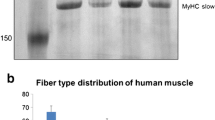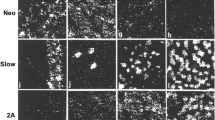Abstract
The myosin heavy chain (MyHC) content in different parts of, two jaw opening muscle, the human lateral pterygoid and the digastric muscles of five young adult and five elderly subjects (mean age 22 and 73 years, respectively) was determined, using gel electrophoresis and immunohistochemical methods. The lateral pterygoid of both young and elderly contained predominantly slow MyHC, and fast A MyHC was the major fast isoform. In contrast, the digastric was composed of slow, fast A and fast X MyHCs in about equal proportions in both age groups. About half of the lateral pterygoid fibres contained mixtures of slow and fast MyHCs, often together with α-cardiac MyHC. In the digastric, co-existence of slow and fast MyHCs was rare, and α-cardiac MyHC was lacking. On the other hand, co-expression of fast A and fast X MyHCs was found more often in the digastric than in the lateral pterygoid. In both age groups about half of the digastric IIB fibres contained solely fast X MyHC. In the lateral pterygoid, type IIB fibres with pure fast X MyHC was found in only one subject. The lateral pterygoid in elderly showed a significant amount of fibres with solely fast A MyHC, which were occasionally found in young adults. In the digastric, no significant differences were found between young and elderly, although the muscles of elderly contained lower mean value of slow MyHC, as compared to that of young muscles. It is concluded that the lateral pterygoid and the digastric muscles differ not only in the MyHC composition but also in modifications of the MyHC phenotypes during aging, suggesting that they have separate roles in jaw opening function.
Similar content being viewed by others
References
Altman DG (1991) Practical Statistics for Medical Research. 1st edn. (pp. 194–197, 334–336) Chapman & Hall, London.
Bär A and Pette D (1988) Three fast myosin heavy chains in adult rat skeletal muscle. FEBS Lett 235: 153–155.
Bottinelli R, Betto R, Schiaffno S and Reggiani C (1994) Unloaded shortening velocity and myosin heavy chain and alkali light chain isoform composition in rat skeletal muscle fibres. J Physiol 478: 341–349.
Bredman JJ, Wessels A, Weijs WA, Korfage JA, Soffers CA and Moorman AF (1991) Demonstration of ‘cardiac-specific’ myosin heavy chain in masticatory muscles of human and rabbit. Histochem J 23: 160–170.
Brooke MH and Kaiser KK (1970) Muscle fiber types: how many and what kind? Arch Neurol 23: 369–379.
Burke RE (1981) Motor units: anatomy, physiology and functional organization. In: Brooks VB (ed.) Handbook of Physiology. Section 1. The Nervous System. Motor Control. (Vol II, pp. 345–422) American Physiological Society, Washington, DC.
Butler-Browne GS, Eriksson P-O, Laurent C and Thornell L-E (1988) Adult human masseter muscle fibers express myosin isozymes characteristic of development. Muscle Nerve 11: 610–620.
Butler-Browne GS, Barbet JP and Thornell L-E (1990) Myosin heavy and light chain expression during human skeletal muscle development and precocious muscle maturation induced by thyroid hormone. Anat Embryol 181: 513–522.
Carraro U and Catani C (1983) A sensitive SDS-PAGE method separating myosin heavy isoforms of rat skeletal muscles reveals the heterogeneous nature of the embryonic myosin. Biochem Biophys Res Commun 116: 793–802.
Dubowitz V (1985) Muscle Biopsy-A Practical Approach. 2nd edn. (pp. 34–102) Bailliére Tindall, London.
Engel WK and Cunningham GG (1963) Rapid examination of muscle tissue. An improved trichrome method for fresh-frozen biopsy sections. Neurology 13: 919–923.
Ennion S, Sant'ana Pereira J, Sargeant AJ, Young A and Goldspink G (1995) Characterization of human skeletal muscle fibres according to the myosin heavy chains they express. J Muscle Res Cell Motil 16: 35–43.
Eriksson P-O, Eriksson A, Ringqvist M and Thornell L-E (1980) The reliability of histochemical fibre typing of human necropsy muscles. Histochemistry 65: 193–205.
Eriksson P-O, Eriksson A, Ringqvist M and Thornell L-E (1981) Special histochemical muscle-fibre characteristics of the human lateral pterygoid muscle. Arch Oral Biol 26: 495–507.
Eriksson P-O, Eriksson A, Ringqvist M and Thornell L-E (1982) Histochemical fibre composition of the human digastric muscle. Arch Oral Biol 27: 207–215.
Eriksson P-O (1982) Muscle-fibre composition of the human mandibular locomotor system. Enzyme-histochemical and morphological characteristics of functionally different parts. Swed Dent J 12: 1–44.
Eriksson P-O and Thornell L-E (1983) Histochemical and morphological muscle-fibre characteristics of the human masseter, the medial pterygoid and the temporal muscles. Arch Oral Biol 28: 781–795.
Eriksson P-O, Butler-Browne GS and Thornell L-E (1994) Immuno-histochemical characterization of human masseter muscle spindles. Muscle Nerve 17: 31–41.
Gambke B and Rubinstein NA (1984) A monoclonal antibody to the embryonic myosin heavy chain of rat skeletal muscle. J Biol Chem 259: 12092–120100.
Havenith MG, Visser R, Schrijvers-van Schendel JM and Bosman FT (1990) Muscle fiber typing in routinely processed skeletal muscle with monoclonal antibodies. Histochemistry 93: 497–499.
Hughes SM, Cho M, Karsch-Mizrachi I, Travis M, Silberstein L, Leinwand LA and Blau HM (1993) Three slow myosin heavy chains sequentially expressed in developing mammalian skeletal muscle. Dev Biol 158: 183–199.
Klitgaard H, Mantoni M, Schiaffino S, Ausoni S, Gorza L, Laurent-Winter C, Schnohr P and Saltin B (1990) Function, morphology and protein expression of ageing skeletal muscle: a cross-sectional study of elderly men with different training backgrounds. Acta physiol Scand 240: 41–54.
Kwa SH, Weijs WA and Juch PJ (1995) Contraction characteristics and myosin heavy chain composition of rabbit masseter motor units. Neurophysiol 73: 538–549.
Larsson L (1992) Is the motor unit uniform? Acta Physiol Scand 144: 143–154.
Larsson L and Moss RL (1993) Maximum velocity of shortening in relation to myosin isoform composition in single fibres from human skeletal muscles. J Physiol 472: 595–614.
Larsson L, Li X and Frontera WR (1997) Effects of aging on shortening velocity and myosin isoform composition in single human skeletal muscle cells. Am J Physiol 272: C638-C649.
Legér JO, Bouvagnet P, Pau B, Roncucci R and Legér JJ (1985) Levels of ventricular myosin fragments in human sera after myocardial infarction, determined with monoclonal antibodies to myosin heavy chains. Eur J Clin Invest 15: 422–429.
Manson JD and Lucas RB (1962) A microradiographic study of age changes in the human mandible. Arch Oral Biol 7: 761–769.
Møller E (1966) The chewing apparatus. An electromyographic study of the action of the muscles of mastication and its correlation to facial morphology. Acta Physiol Scand (Suppl 280) (Copenhagen) 69: 1–299.
Monemi M, Eriksson P-O, Dubail I, Butler-Browne GS and Thornell L-E (1996) Fetal myosin heavy chain increases in the human masseter muscle during aging. FEBS Lett 386: 87–90.
Monemi M, Eriksson P-O, Eriksson A and Thornell L-E (1998) Adverse changes in fibre type composition of the human masseter versus biceps brachii muscle during aging. J Neurol Sci 154: 35–48.
Monemi M, Eriksson P-O, Kadi F, Butler-Browne GS and Thornell L-E (1999a) Opposite changes in myosin heavy chain composition of human masseter and biceps brachii muscles during aging. J Muscle Res Cell Motil 20: 351–361.
Monemi M, Eriksson P-O and Thornell L-E (1999b) Diverse changes in fibre type composition of the human lateral pterygoid and digastric muscles. J Neurol Sci 171: 38–48.
Noden DM (1983) The embryonic origins of avian cephalic and cervical muscles and associated connective tissues. Am J Anat 168: 257–276.
Pedrosa-Domellöf F, Eriksson P-O, Butler-Browne GS and Thornell L-E (1992) Expression of alpha-cardiac myosin heavy chain in mammalian skeletal muscle. Experientia 48: 491–494.
Sant'Ana Pereira JA, Ennion S, Sargeant AJ, Moorman AF and Goldspink G (1997) Comparison of the molecular, antigenic and ATPase determinants of fast myosin heavy chains in rat and human: a single-fibre study. Pflugers Arch 435: 151–163.
Schiaffino S, Saggin L, Viel A, Ausoni S, Sartore S and Gorza L (1986) Muscle fiber types identified by monoclonal antibodies to myosin heavy chains. In: Benzi G, Packer L and Siliprandi N (eds) Biochemical Aspects of Physical Exercise. (pp. 27–34) Elsevier, Amsterdam.
Schiaffino S, Gorza L, Sartore S, Saggin L, Ausoni S, Vianello M, Gundersen K and Lomo T (1989) Three myosin heavy chain isoforms in type 2 skeletal muscle fibres. J Muscle Res Cell Motil 10: 197–205.
Sciote JJ, Rowlerson AM, Hopper C and Hunt NP (1994) Fibre type classification and myosin isoforms in the human masseter muscle. J Neurol Sci 126: 15–24.
Smerdu V, Karsch-Mizrachi I, Campione M, Leinwand L and Schiaffiano S (1994) Type IIx myosin heavy chain transcripts are expressed in type IIb fibers of human skeletal muscle. Am J Physiol 267: C1723-C1728.
Stål P, Eriksson P-O, Schiaffino S, Butler-Browne GS and Thornell L-E (1994) Differences in myosin composition between human oro-facial, masticatory and limb muscles: enzyme-, immunohisto-and biochemical studies. J Muscle Res Cell Motil 15: 517–534.
Staron RS (1991) Correlation between myofibrillar ATPase activity and myosin heavy chain composition in single human muscle fibres. Histochemistry 96: 21–24.
Sternberger LA (1979) Immunohistochemistry. 2nd edn., Wiley Medical, New York.
Weiss A, Schiaffino S and Leinwand LA (1999) Comparative sequence analysis of the complete human sarcomeric myosin heavy chain family: implications for functional diversity. J Mol Biol 290: 61–75.
Author information
Authors and Affiliations
Rights and permissions
About this article
Cite this article
Monemi, M., Liu, JX., Thornell, LE. et al. Myosin heavy chain composition of the human lateral pterygoid and digastric muscles in young adults and elderly. J Muscle Res Cell Motil 21, 303–312 (2000). https://doi.org/10.1023/A:1005632624826
Issue Date:
DOI: https://doi.org/10.1023/A:1005632624826




